Server Migration Center (SMC) allows you to migrate incremental data from a VMware VM to Alibaba Cloud. You can specify the time interval between incremental migration operations. Incremental migration reduces the VM downtime and the total duration of cutover. This topic describes how to migrate incremental data from a VMware VM without an agent.
Limits
When you create an incremental migration job, you must set the Destination Type parameter to ECS Image.
Procedure
Step 1: Enable CBT
In this topic, vCenter 6.7 is used. Perform the following steps to enable Changed Block Tracking (CBT). To migrate incremental data from a VMware VM, you must enable CBT for the VM. If you disable CBT, full data is migrated from the VMware VM. If CBT is already enabled, skip this step.
Before you enable CBT, make sure that no snapshots are generated for the VMware VM. Otherwise, the incremental data migrated by using CBT may be incorrect. If you delete the snapshots of the VMware VM when you enable CBT, execute the ./disk/migrate_configure file in the /root/smc directory, which is the home directory of the SMC client. This way, you can reobtain the configuration information about the VMware VM.
To enable CBT, make sure that the following conditions are met:
The version of the ESXi host is ESXi 4.0 or later.
The VM hardware version is 7 or later.
The I/O operations of the VMware VM must be performed in the ESXi storage.
The VMware VM supports Raw Device Mapping (RDM) and Virtual Machine File System (VMFS) in virtual compatibility mode and Network File System (NFS).
The VMware VM does not use independent persistent or nonpersistent disks to store data.
Log on to vCenter Server.
Right-click the VMware VM that has been powered off and select Edit Settings.
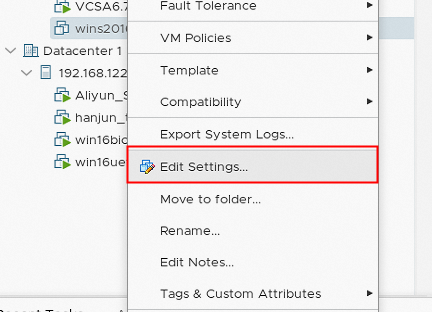
On the Edit Settings page, click the VM Options tab.
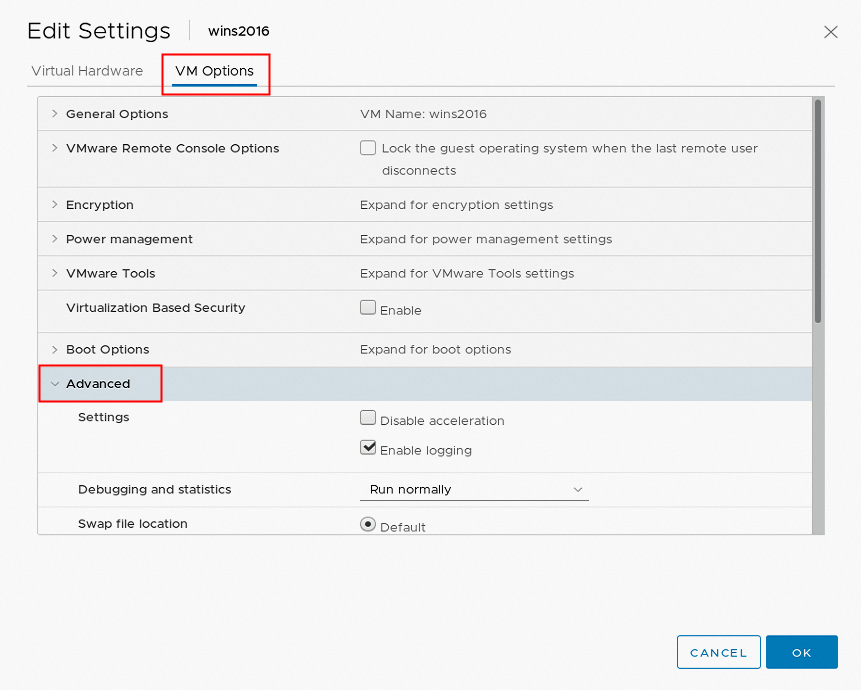
Click Advanced and then click EDIT CONFIGURATION... next to Configuration Parameters.
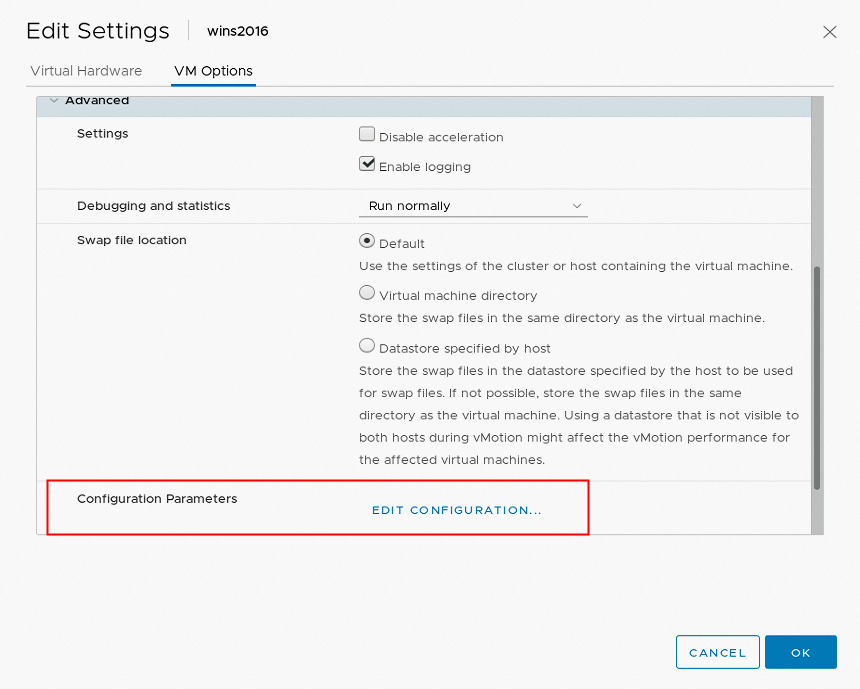
On the Configuration Parameters page, click ADD CONFIGURATION PARAMS and add the parameters that are described in the following table.
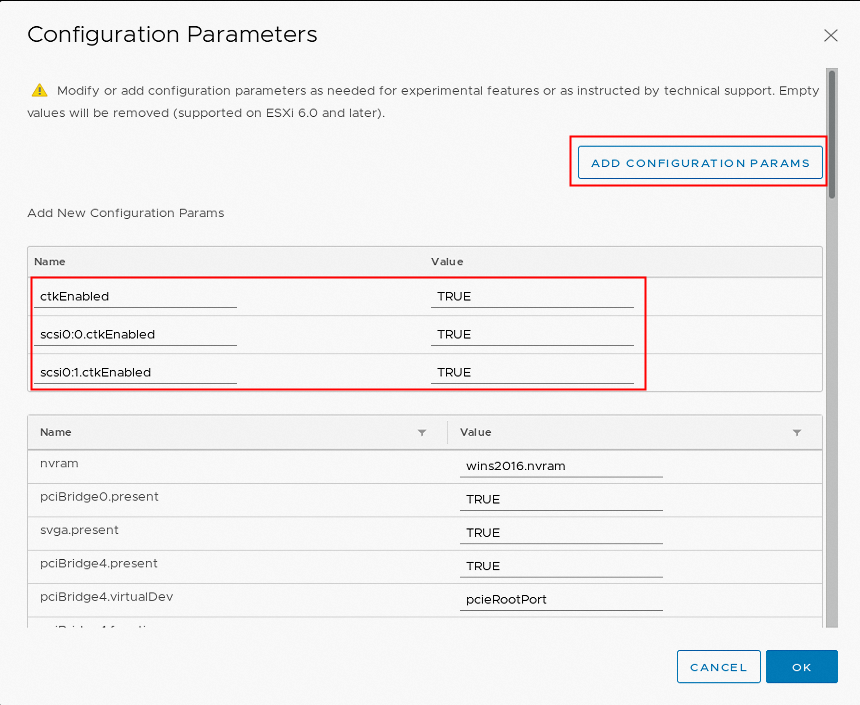
Name
Value
Description
ctkEnabled
TRUE
Specifies whether to use CTK files.
scsi0:0.ctkEnabled
TRUE
Specifies whether to allow the use of CTK files for the hard disk whose small computer systems interface (SCSI) ID is 0:0.
scsi0:1.ctkEnabled
TRUE
Specifies whether to allow the use of CTK files for the hard disk whose SCSI ID is 0:1.
In the scsix:x.ctkEnabled parameter, x:x indicates the SCSI ID. Replace x:x with an SCSI ID based on your business requirements. In this topic, hard disks whose SCSI IDs are 0:0 and 0:1 are used. To query the SCSI IDs of hard disks in the VM, go to the Virtual Hardware tab of the Edit Settings page.
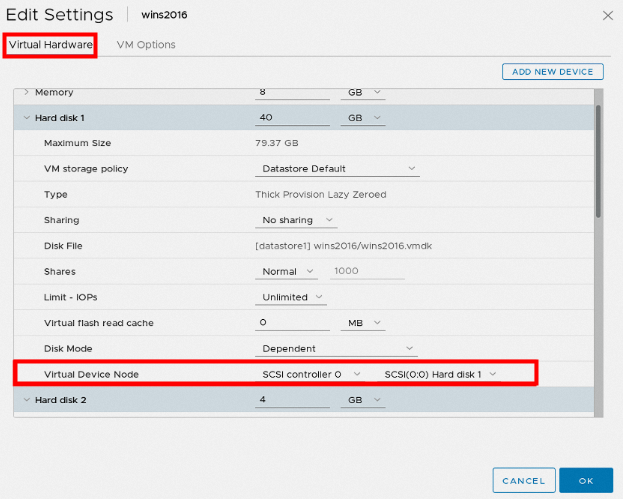
Click OK. Then, right-click the VMware VM and choose to power on the VMware VM.
If CBT is enabled, a xx-ctk.vmdk file is added to each virtual disk and snapshot disk.

Step 2: Create and start an incremental migration job
After you import the information about a migration source in the SMC console, perform the following steps to create and start an incremental migration job. You do not need to stop your services that are running on the VM. For more information, see Migrate VMware VMs without agents.
When you create a migration job, turn on Automatic Incremental Synchronization in the Advanced Settings section.
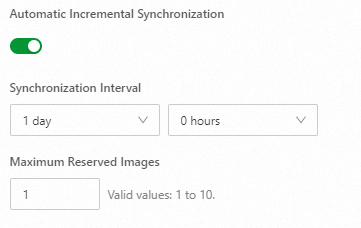
Configure the following parameters related to automatic incremental migration:
Automatic Incremental Synchronization: specifies whether to enable automatic incremental migration. Turn on this switch.
Synchronization Interval: the time interval between two consecutive incremental migration operations. You can specify a time interval in the range of one hour to seven days.
Maximum Reserved Images: the maximum number of images that can be retained during incremental migration. Valid values: 1 to 10. An image is generated for each incremental migration operation. If the total number of images exceeds the upper limit, the earliest unused image is deleted.
The migration job immediately starts after it is created. Data is migrated in the following way:
During the first incremental migration operation, SMC migrates all data except the excluded directories and files, and generates a full image. You can use this image to create an Elastic Compute Service (ECS) instance for verification.
After the first incremental migration operation is complete, SMC automatically migrates incremental data and generates images at specific points in time based on the value of the Synchronization Interval parameter.
NoteThe image generated for each incremental migration operation is a full image of the source server at a specific point in time. The image contains the incremental data at the point in time of migration and all earlier migrated data.
After an incremental migration operation is complete, the migration job enters the Waiting state and runs at the next specified point in time to migrate incremental data.
Optional. You can also manually run the incremental migration job that is in the Waiting state. Perform the following steps:
On the OS Migration page, find the migration job that you want to run and click Manual Incremental Synchronization in the Actions column.

In the Manual Incremental Synchronization message, click Confirm.
NoteIf you want to pause an incremental migration job, find the migration job, move the pointer over the icon in the Actions column and select Pause.
If you want to delete an incremental migration job, find the migration job, move the pointer over the icon in the Actions column and select Delete.
View the incremental migration result.
If the migration progress is 100%, the incremental migration is complete.

Step 3: Stop the services on the VMware VM and run the incremental migration job again
To ensure that all data can be migrated to Alibaba Cloud, stop the services on the VMware VM and run the incremental migration job during off-peak hours.
In the SMC console, manually run the incremental migration job or wait for the job to automatically run.
SMC automatically runs the incremental migration job based on the value of the Synchronization Interval parameter.
Step 4: Complete incremental synchronization
After the last incremental migration operation is complete, perform the following steps to complete incremental migration.
On the OS Migration page, find the migration job that you want to manage and click Complete Incremental Synchronization in the Actions column.

In the Run Incremental Job dialog box, click OK.
You can also select Perform One Last Synchronization in the Run Incremental Job dialog box to perform the last incremental migration operation.

On the Migration Jobs page, view the status of the created job.
The amount of time required for data transmission is subject to factors such as the data size of the migration source and network bandwidth. Wait until the migration job is complete.



 > Delete
> Delete